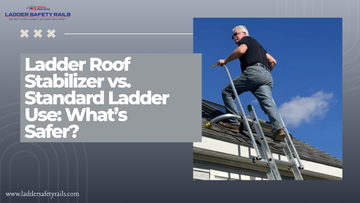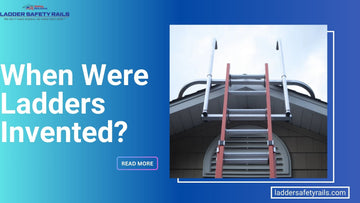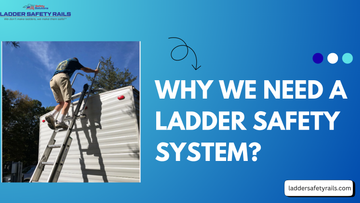
When it comes to working at heights, the debate of ladder roof stabilizer vs. standard ladder often comes down to one crucial question: what’s safer? Whether you're a seasoned contractor scaling rooftops daily or a weekend DIYer cleaning out the gutters, your choice of equipment can make a significant choice.
A ladder may seem simple, just two rails and some rungs, right? But when you are 10 or 15 feet up, the margin for error vanishes. Standard ladders lack the security of a roof ladder stabilizer, especially on sloped or uneven surfaces. Let’s be honest, one slip on an unsteady ladder can turn a minor task into a serious injury.
Before your next home project or job site task, let’s find out which option is safer.
What Is a Ladder Roof Stabilizer?
A ladder roof stabilizer is a clever add-on that attaches to the top of an extension ladder. It spreads the ladder’s contact point across a wider area,usually the roof edge or siding, helping it grips securely and stay put while you work.
Some stabilizers are designed with padded or rubber feet to prevent scratching surfaces, while others are more rugged and built for heavy-duty construction jobs. Either way, this small addition to your ladder setup can do a lot of heavy lifting.
If you are working on the roof, whether you're painting, putting up lights, or removing leaves from the gutter, a system for ladder safety like this is not just a good choice, it's essential.
Why Do Ladder Stabilizers Improve Safety?
Ladder stabilizer as a support for your ladder, is there to keep things steady when the job gets risky. These handy attachments lock into the top of the ladder and give it a wider stance, which helps prevent side-to-side movement or sliding.
If you ever felt that gut-clenching sway when you shift your weight on a ladder, then you already know how valuable that extra stability can be. A ladder stabilizer on roof jobs makes a significant difference. It reduces bounce and vibration, two things that can throw off your balance and cause fatigue while you're up there trying to concentrate.
When you're working on shingles, tile, or metal roofing, surface friction isn’t always reliable. That’s why a ladder stability device can offer a real safety upgrade as it provides extra grip, spreads out the ladder’s pressure, and creates more consistent contact with the roofline.
For those doing extended work at height, like painting siding, installing solar panels, or trimming trees, the difference between a shaky ladder and a stabilized one is significant.
Pros and Cons of Using a Standard Ladder Alone

Using a basic, standard ladder, without any stabilizers, add-ons, or safety enhancements, is still common. As standard ladders are light, portable, and quick to set up. You can get up and down fast, and for small indoor jobs, that may be all you need.
But when you’re using one outside, especially on uneven terrain or near a roofline, that comes at a cost.
Without any kind of ladder safety device, you’re relying on favorable conditions like: flat ground, dry weather etc. Unfortunately, life and job sites aren’t always that favorable. A gust of wind or a slight lean can send your ladder wobbling or toppling over. It is a risk that professionals try to minimize wherever possible.
And that’s just safety. There’s also the risk of damaging the thing you’re trying to fix. Standard ladders without stabilizers often rest directly against gutters, trim, or siding, areas that aren’t designed to hold your weight. This can lead to crushed gutters or dented panels before you start the real work.
A standard ladder may get the job done, but without a ladder stabilizer, you’re working without protection.
Ladder Safety Devices: A Must-Have for Roof Work
If you’re going to climb on the roof, a ladder safety device is essential. It doesn’t matter whether you're up there for five minutes or five hours, one slip is all it takes.
So yes a roof ladder stabilizer can turn an everyday extension ladder into a much safer tool, especially on sloped or uneven roofs. The stabilizer helps prevent the ladder from shifting under your weight or slipping as you climb down. When you're trying to lift up other tools and materials, that added stability becomes more important.
Some models come with additional features, like ladder safety rails that act as mini handrails, giving you something to grip as you ascend or descend from the top of the ladder. Others are designed to work with harnesses or tie-off systems for more protection.
Don’t forget, working at heights affects your perception of balance. If the ladder feels solid at the base, your body responds differently when you’re standing 15 feet up. That’s where ladder safety systems help as they let you focus on the task.
Key Ladder Safety Tips for Every User
Whether you're an experienced person or just tackling weekend chores, following basic ladder safety tips is a non-negotiable part of working smart.
1. Inspect your ladder every time:
Before you unfold it, take a moment to check for damage. Bent rungs, cracked rails, and loose bolts can all lead to catastrophic events. The feet of ladder should be inspected, worn rubber or uneven pads can throw off your balance
2. Use a stabilizer on soft or uneven ground:
If you're setting up on grass, gravel, mulch, or an old driveway, your ladder can sink or shift without warning. A ladder stabilizer can help with ground-level work and can keep things level and secure.
3. Watch your ladder angle:
For every four feet of height, the base should be one foot out from the wall. Too steep, and it may fall backward. Too shallow, and it could fall over.
4. Don’t overload it:
Every ladder has a weight rating, and that includes you and your gear. Tools, paint cans, buckets everything counts. It’s not about the ladder holding your weight, it’s about holding it the correct way.
5. Use additional fall protection:
For serious roof jobs, combine your stabilizer with a harness, anchor, or rail system. These ladder safety systems may feel like an over burden at first, but once you have experience it gives you peace of mind.
How to Set Up Your Extension Ladder Safely?![]()

An extension ladder offers the reach you need for your work, but with that reach comes risk. As your working height increases, it's important to have some kind of extension ladder safety equipment with you.
The solution is to pair your ladder with a roof ladder stabilizer. The added width gives your ladder more surface contact, which means less shifting, less swaying, and a more secure platform underfoot. It also ensures a smoother transition when climbing up and stepping onto the roof eliminating unsteady movements and improving safety at the top.
If you're doing work that involves leaning against gutters or eaves, a ladder stabilizer with rubber grips helps prevent damage while providing a stable anchor point. For tasks that take long durations like cleaning out leaves or installing roof flashing your legs and back will have that added stability.
And if you're questioning whether all this extra equipment is worth it, just think of it this way: when your feet are on the ladder, your life depends on it. Get the stability that’s needed.
Comparing Ladder Safety Systems: Which Works Best?
Let’s break down the most common ladder safety devices and how they perform in real-life situations:
|
Safety System |
Best Use Case |
Pros |
Cons |
|
Standard Ladder Only |
Short, low-risk tasks |
Lightweight, fast setup |
No added stability, higher risk |
|
Ladder Roof Stabilizer |
Roofing, exterior walls |
High stability, easy to install |
Slightly bulkier, adds setup time |
|
Ladder Safety Rails |
Frequent climbing tasks |
Hand support, added confidence |
Cost, installation required |
|
Full Fall Protection System |
High-risk or pro jobs |
Ultimate safety, OSHA-approved |
Expensive, complex setup |
For many homeowners and handymen, a good-quality ladder stabilizer offers perfect balance, affordable, easy to use, and significant safety upgrade.
Are Ladder Stability Devices Worth the Investment?
Ladders are here to stay. If it's trimming trees, fixing gutters to hanging decorations we all rely on them. But if you’ve had that sinking feeling when a ladder shifts beneath you, then you understand how valuable a ladder stability device can be.
These tools aren’t just for contractors and for daily workers. They’re for everyone who values safety, efficiency, and peace of mind. Many ladder stabilizers are compatible with standard extension ladders and can be installed easily. They don’t add much weight, but they do add stability.
Next time you use your ladder, consider this: would you rather climb with confidence or rely on uncertain chances?
Final Thoughts
So, what’s the bottom line in the ladder roof stabilizer vs. standard ladder debate? If safety, stability, and peace of mind matter to you and they absolutely should, a ladder stabilizer is the clear winner.
It’s more than just an upgrade; it’s a simple, cost-effective solution that dramatically enhances your safety. Whether you're clearing gutters, installing decorations, or tackling a full roofing project, a stabilizer keeps every climb steady, secure, and stress-free.
Looking to level up your ladder setup? Explore Ladder Safety Rails, your trusted source for top-quality stabilizers, rails, and safety gear designed for real-world use. Our products are reliable, easy to install, and built with your safety in mind.
Shop smart. Climb safer. Trust Ladder Safety Rails.
FAQs
-
What is the best method for stabilizing a ladder?
The effective method to use a ladder roof stabilizer, when working at height or on inclined surfaces. It provides broader contact, better grip, and a significant improvement in balance and overall safety.
-
What is the standard for ladders?
Standard ladders must meet safety guidelines set by OSHA and ANSI. As for added safety, using a ladder safety device is advised.
-
What are standard size ladders?
Common extension ladders range feet 16 to 40 feet. A standard ladder for residence use is 20 to 28 feet. When using over 20 feet, a ladder stabilizer for roof access is recommended.
-
How do you stabilize a ladder on a roof?
Use an extension ladder roof stabilizer that attaches securely to the ladder’s top. It increases contact area and reduces movement. Additionally, ensure the base is on level ground and consider using safety tie-offs.
-
How to stabilize a wobbly ladder?
Start by inspecting the ladder feet and ground. If instability remains, use a stabilizer to reduce movement and enhance balance. Never use a ladder that feels unsafe
Read More Blog Here.





